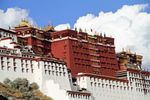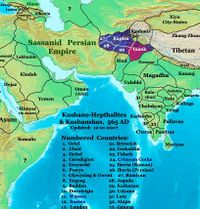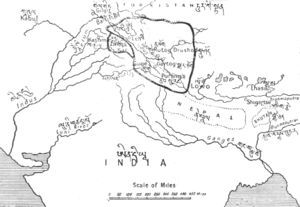ژانگژونگ
مملكة ژانگژونگ ཞང་ཞུང་ (شانگشونگ) | |||||||||
|---|---|---|---|---|---|---|---|---|---|
| 500 ق.م.–625 | |||||||||
| العاصمة | كيونگلونگ | ||||||||
| اللغات الشائعة | لغة ژانگژونگ | ||||||||
| الدين | بون (ديانة) | ||||||||
| الحكومة | ملكية | ||||||||
| برتسانپو | |||||||||
| الحقبة التاريخية | العصر الحديدي إلى القِدم الكلاسيكي | ||||||||
• تأسست | 500 ق.م. | ||||||||
• فتح سونگتسن-گامپو | 625 | ||||||||
| |||||||||
| ژانگژونگ | |||||||
| الاسم التبتي | |||||||
|---|---|---|---|---|---|---|---|
| Tibetan | ཞང་ཞུང་ | ||||||
| |||||||
| الاسم الصيني | |||||||
| Simplified Chinese | 象雄 | ||||||
| |||||||
جزء من سلسلة عن |
|---|
| تاريخ التبت |
 |
| انظر أيضاً |
ژانگژونگ Zhangzhung أو شانگشونگ Shangshung كانت حضارة ومملكة قديمة قي غرب وجنوب غرب التبت، سبقت ثقافة البوذية التبتية في التبت. اقترنت ثقافة ژانگژونگ بديانة بون، التي بدورها أثـَّرت على فلسفات وشعائر البوذية التبتية. شخصيات ژانگژونگ مذكورون كثيراً في النصوص التبتية القديمة بصفتهم الحكام الأصليون لوسط وغرب التبت. فقط في العقدين الأخيرين تمكن علماء الآثار من الوصول للآثار في المناطق التي كانت تحكمها ژانگژونگ.
ومؤخراً، اِقتـُرِح تناظر مبدئي بين ژانگژونگ وثقافة من العصر الحديدي تم الكشف عنها مؤخراً في هضبة تشانگتانگ في شمال غرب التبت.[بحاجة لمصدر]
امتداد ممالك ژانگژونگ
حسب حوليات بحيرة مناساروار (بحيرة مناساروار)، ففي وقتٍ ما، تكونت حضارة ژانگژونگ من 18 مملكة في غرب وشمال غرب التبت. تمركزت ثقافة ژانگژونگ حول جبل كايلاش المقدس وامتدت غرباً إلى سرمت و لداخ و بلتستان الحاليتين، وجنوب غرباً إلى Jalandhar، وجنوباً إلى مملكة موستانگ في نـِپال، وشرقاً لتضم وسط التبت، وشمالاً عبر هضبة تشانگ تانگ الشاسعة و صحراء تكلامكان إلى شانشان. ولذلك فإن ثقافة ژانگژونگ سيطرت على الجزء الأكبر من "سقف العالم".
عاصمة ژانگ ژونگ كانت تُدعى كيونگ لونگ (وايلي: Khyunglung Ngülkhar أو وايلي: Khyung-lung dngul-mkhar)، "القصر الفضي لـگارودا"، جنوب غرب جبل كايلاش (جبل تي-سى)، والتي تُعرف بالقصور الموجودة فيها في أعلى وادي سوتلج.[1]
شيـَّـد الژانگژونگ الحصن الشامخ، تشوگتسو دروپو، على شاطئ بحيرة دانگرا المقدسة، والتي منها مارسوا قوتهم العسكرية على المنطقة المحيطة في وسط التبت.
تاريخ ژانگژونگ
ثقافة العصر الحديدي تشانگ تانگ—الژانگژونگ ؟
فتح ژانگژونگ
ويوجد التباس حول ما إذا قام وسط التبت بفتح ژانگژونگ في عهد سونگتسن-گامپو (605 أو 617 - 649) أو في عهد تريسونگ دتسن (وايلي: Khri-srong-lde-btsan), (r. 755 until 797 or 804).[2] سجلات حوليات تانگ do, however, seem to clearly place these events in the reign of Songtsän Gampo for they say that in 634, Yangtong (Zhang Zhung) and various Qiang tribes, "altogether submitted to him." Following this he united with the country of Yangtong to defeat the 'Azha or Tuyuhun, and then conquered two more tribes of Qiang before threatening Songzhou with an army of more than 200,000 men. He then sent an envoy with gifts of gold and silk to the Chinese emperor to ask for a Chinese princess in marriage and, when refused, attacked Songzhou. He apparently finally retreated and apologised and later the emperor granted his request.[3][4]
الروايات التبتية المبكرة تقول أن كلاً من الملك التبتي وملك ژانگژونگ تزوجا أخت الآخر في تحالف سياسي. إلا أن الزوجة التبتية لملك ژانگژونگ اشتكت من المعاملة السيئة من الزوجة الرئيسية للملك. فنشبت الحرب، and through the treachery of the Tibetan princess, "King Ligmikya of Zhangzhung, while on his way to سوم-با (Amdo province) was ambushed and killed by King Srongtsen Gampo's soldiers. ونتيجة لذلك، فقد أُلحِقت مملكة ژانگژونگ بدولة بود (وسط التبت). ومنذ ذلك الحين، وُلِدت مملكة جديدة من توحيد ژانگژونگ و بود، عـُرِفت بإسم بود رگيال-خاب."[5][6][7] R. A. Stein places the conquest of Zhangzhung in 645.[8]
ثورة ژانگژونگ في 677
ثارت ژانگژونگ مباشرة بعد وفاة الملك Mangsong Mangtsen or Trimang Löntsän (وايلي: Khri-mang-slon-rtsan, r. 650–677)، ابن Songtsän Gampo, but was brought back under Tibetan control by the "firm governance of the great leaders of the Mgar clan".[9]
لغة ژانگژونگ
حفنة من نصوص ژانگژونگ ووثائق تبتية ثنائية اللغة من القرن الحادي عشر تشهد بوجود لغة ژانگژونگ التي كانت على صلة بالكنـّوري. The Bonpo claim that the Tibetan writing system is derived from the Zhangzhung alphabet, while modern scholars recognize the clear derivation of Tibetan script from a North Indian script, which accords with non-Bon Tibetan accounts. A modern Kinnauri language called by the same name (pronounced locally Jangshung) is spoken by 2,000 people in the Sutlej Valley of Himachal Pradesh who claim to be descendants of the Zhangzhung.[10]
تأثير ثقافة ژانگژونگ في الهند
It is noteworthy that the Bonpo tradition claims that it was founded by a Buddha-like figure named Tonpa Shenrab Miwoche,[11] to whom are ascribed teachings similar in scope to those ascribed to بوذا التاريخي. Bonpos claim that Tonpa Shenrab Miwoche lived some 18,000 years ago, and visited Tibet from the land of Tagzig Olmo Lung Ring, or Shambhala. Bonpos also suggest that during this time Lord Shenrab Miwoche's teaching permeated the entire subcontinent and was in part responsible for the development of the Vedic religion. An example of this link is said to be Mount Kailash, which is the center of Zhang Zhung culture, and also the most sacred mountain to Hindus. As a result, the Bonpos claim that the supposedly much later teaching at least indirectly owes its origin to Tonpa Shenrab Miwoche.
انظر أيضاً
الهامش
- ^ Allen, Charles. (1999). The Search for Shangri-La: A Journey into Tibetan History. Abacus Edition, London. (2000), pp. 266-267; 273-274. ISBN 0-349-11142-1.
- ^ Karmey, Samten G. (1975). "'A General Introduction to the History and Doctrines of Bon", p. 180. Memoirs of Research Department of The Toyo Bunko, No, 33. Tokyo.
- ^ Lee, Don Y. (1981). The History of Early Relations between China and Tibet: From Chiu t'ang-shu, a documentary survey, pp. 7–9. Eastern Press, Bloomington, IN.
- ^ Pelliot, Paul. (1961). Histoire ancienne du Tibet, pp. 3–4. Librairie d'Amérique et d'orient, Paris.
- ^ Norbu, Namkhai. (1981). The Necklace of Gzi, A Cultural History of Tibet, p. 30. Information Office of His Holiness The Dalai Lama, Dharamsala, H.P., India.
- ^ Beckwith, Christopher I. (1987). The Tibetan Empire in Central Asia, p. 20. Princeton University Press, Princeton, NJ. Fourth printing with new afterword and 1st paperback version. ISBN 0-691-02469-3.
- ^ Allen, Charles. The Search for Shangri-La: A Journey into Tibetan History, pp. 127–128. (1999). Reprint: (2000). Abacus, London. ISBN 0-349-11142-1.
- ^ Stein, R. A. (1972). Tibetan Civilization, p. 59. Stanford University Press, Stanford California. ISBN 0-8047-0806-1 (cloth); ISBN 0-8047-0901-7.
- ^ Beckwith, Christopher I. The Tibetan Empire in Central Asia. A History of the Struggle for Great Power among Tibetans, Turks, Arabs, and Chinese during the Early Middle Ages, 1987, Princeton: Princeton University Press. ISBN 0-691-02469-3, p. 43.
- ^ Ethnologue 14 report for language code:JNA
- ^ http://www.ligmincha.org/bon/founder.html
المصادر
- Allen, Charles. (1999) The Search for Shangri-La: A Journey into Tibetan History. Little, Brown and Company. Reprint: 2000 Abacus Books, London. ISBN 0-349-11142-1.
- Bellezza, John Vincent: Zhang Zhung. Foundations of Civilization in Tibet. A Historical and Ethnoarchaeological Study of the Monuments, Rock Art, Texts, and Oral Tradition of the Ancient Tibetan Upland. Denkschriften der phil.-hist. Klasse 368. Beitraege zur Kultur- und Geistesgeschichte Asiens 61, Verlag der Oesterreichischen Akademie der Wissenschaften, Wien 2008.
- Hummel, Siegbert. (2000). On Zhang-zhung. Edited and translated by Guido Vogliotti. Library of Tibetan Works and Archives. Dharamsala, H.P., India. ISBN 81-86470-24-7.
- Karmey, Samten G. (1975). A General Introduction to the History and Doctrines of Bon. Memoirs of the Research Department of the Toyo Bunko, No. 33, pp. 171–218. Tokyo.
- Stein, R. A. (1961). Les tribus anciennes des marches Sino-Tibétaines: légends, classifications et histoire. Presses Universitaires de France, Paris. (In French)
- Zeisler, Bettina. (2010). "Ëast of the Moon and West of the Sun? Approaches to a Land with Many Names, North of Ancient India and South of Khotan." In: The Tibet Journal, Special issue. Autumn 2009 vol XXXIV n. 3-Summer 2010 vol XXXV n. 2. "The Earth Ox Papers", edited by Roberto Vitali, pp. 371–463.
للاستزادة
- Bellezza, John Vincent. (2010). "gShen-rab Myi-bo, His life and times according to Tibet’s earliest literary sources." Revue d’Etudes Tibétaines Number 19 October 2010, pp. 31–118.
- Blezer, Henk. (2010). "Greatly Perfected, in Space and Time: Historicities of the Bon Aural Transmission from Zhang zhung." In: The Tibet Journal, Special issue. Autumn 2009 vol XXXIV n. 3-Summer 2010 vol XXXV n. 2. "The Earth Ox Papers", edited by Roberto Vitali, pp. 71–160.
- Zeisler, Bettina (2010). “East of the Moon and West of the Sun? Approaches to a Land with Many Names, North of Northern India and South of Khotan.” In: The Earth Ox Papers. Special Issue. The Tibet Journal, Autumn 2009 vol XXXIV n 3-Summer 2010 vol. SSSV n. 2. Edited by Roberto Vitali. Library of Tibetan Works and Archives, Dharamsala, H.P., India. pp. 371–463.
وصلات خارجية
- Pages using infobox country with unknown parameters
- Articles containing Standard Tibetan-language text
- Articles containing صينية-language text
- Portal-inline template with redlinked portals
- Pages with empty portal template
- Articles with unsourced statements from February 2007
- مقالات تحتوي نصوصاً باللغة التبتية
- Articles with hatnote templates targeting a nonexistent page
- تاريخ التبت
- آسيا العصر الحديدي
- الحضارات الأثرية في شرق آسيا
- بون
- آثار التبت





